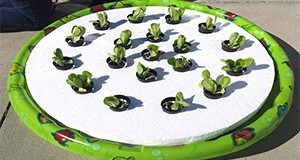Abstract
School gardens are a great way to get youth interested in where their food comes from. Hydroponics, or the cultivation of plants in liquid nutrient solutions rather than in soil, is a fascinating way to teach students about food systems. This 4-page fact sheet lists the materials, tools, and construction steps needed to grow a variety of crops in a wading pool hydroponic garden. Written by Edmund L. Thralls, and published by the UF Department of Environmental Horticulture, October 2015.
ENH1264/EP525: School Garden—Plastic Wading Pool Hydroponics (ufl.edu)
References
Brown, S., K. Ruppert, K. Hendry, and B. Shutzman. 2011. How to Build a Plant Lighting System. MG341. Gainesville: University of Florida Institute of Food and Agricultural Sciences. Accessed January 2, 2016. http://ufdcimages.uflib.ufl.edu/IR/00/00/38/76/00001/MG34100.pdf https://doi.org/10.1093/cs/cdw036
Crossley, P. L. 2004. "Just Beyond the Eye: Floating Gardens in Aztec Mexico." Historical Geography 32: 111-35.
Ozer, E. J. 2007. "The Effects of School Gardens on Students and Schools: Conceptualization and Considerations for Maximizing Healthy Development." Health Educ. Behav. 34(6): 846-863. doi: 10.1177/1090198106289002 https://doi.org/10.1177/1090198106289002
Sweat, M., R. Tyson, and R. Hochmuth. 2013. Building a Floating Hydroponic Garden. HS943. Gainesville: University of Florida Institute of Food and Agricultural Sciences. Accessed October 6, 2015. http://edis.ifas.ufl.edu/hs184
Crossley, P. L. 2004. "Just Beyond the Eye: Floating Gardens in Aztec Mexico." Historical Geography 32: 111-35.
Ozer, E. J. 2007. "The Effects of School Gardens on Students and Schools: Conceptualization and Considerations for Maximizing Healthy Development." Health Educ. Behav. 34(6): 846-863. doi: 10.1177/1090198106289002 https://doi.org/10.1177/1090198106289002
Sweat, M., R. Tyson, and R. Hochmuth. 2013. Building a Floating Hydroponic Garden. HS943. Gainesville: University of Florida Institute of Food and Agricultural Sciences. Accessed October 6, 2015. http://edis.ifas.ufl.edu/hs184

